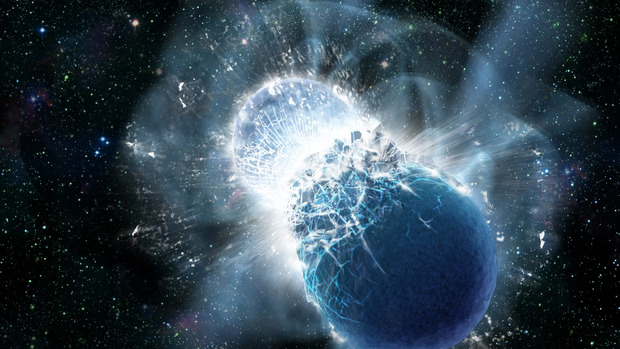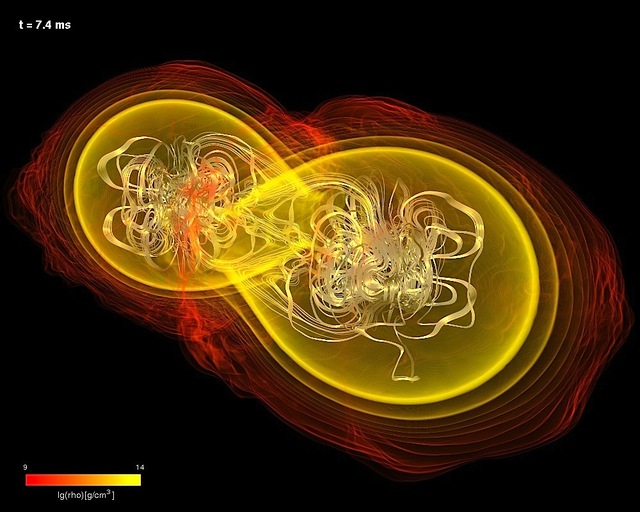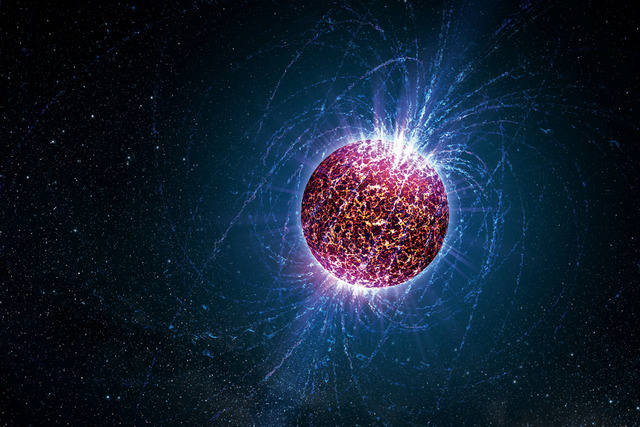
Artist's depiction of a neutron star collision after inspiral. (Credit: NASA/Swift/Dana Berry)
Sources and Types of Gravitational Waves
Technically speaking, every physical object that accelerates produces gravitational waves. This includes humans, cars, airplanes etc. But the masses and accelerations of objects on Earth are far too small to make gravitational waves big enough to detect with our instruments. To find big enough gravitational waves, we have to look far outside of our own solar system.
The Universe is filled with incredibly massive objects undergoing rapid accelerations that generate gravitational waves that we can now detect. Known objects are pairs of black holes or neutron stars orbiting each other, or a neutron star and black hole orbiting each other or gigantic stars blowing themselves up at the ends of their lives. Astronomers have defined four categories of gravitational waves based on what object or system generates the waves: Continuous, Compact Binary Inspiral, Stochastic, and Burst. Each category of objects generates a characteristic set of gravitational-wave signals that researchers can look for in U.S. National Science Foundation Laser Interferometer Gravitational-wave Observatory (NSF LIGO) data.
Click on the links below to learn about each type of gravitational wave that LIGO is tuned to detect:
- Compact Binary Inspiral Gravitational Waves
- Continuous Gravitational Waves
- Stochastic Gravitational Waves
- Burst Gravitational Waves.
Compact Binary Inspiral Gravitational Waves
The first class of gravitational waves NSF LIGO is hunting for is Compact Binary Inspiral gravitational waves. So far, all of the objects LIGO has detected fall into this category. Compact binary inspiral gravitational waves are produced by orbiting pairs of massive and dense ("compact") objects like black holes and neutron stars. There are three subclasses of "compact binary" systems in this category:
- Binary Neutron Star (BNS) - two neutron stars orbiting each other
- Binary Black Hole (BBH) - two black holes orbiting each other
- Neutron Star-Black Hole Binary (NSBH) - a neutron star and a black hole orbiting each other
Each binary pair creates a unique pattern of gravitational waves that depends on, among other things, the masses of each object, how their orbits are oriented with respect to the Earth, and how far away they are, but the mechanism of wave-generation is the same across all three. It is called "inspiral".
Inspiral occurs over millions of years as pairs of dense compact objects revolve around each other. As they orbit, they radiate gravitational waves that carry away some of the system's orbital energy. Over millennia, this causes the objects to move closer and closer together. The closer they are, the faster they orbit each other, which causes them to radiate stronger gravitational waves, which causes them to lose more orbital energy, inch ever closer, orbit faster, lose more energy, move closer, orbit faster... etc. The objects are doomed, inescapably locked in a runaway accelerating spiraling embrace.
|
This computer simulation shows the collision of two black holes, as observed for the first time ever by LIGO on September 14, 2015. The black holes in the animation are based on the actual data from the collision. [Simulating eXtreme Spacetimes (SXS) Project, http://www.black-holes.org] |
|
This accelerating spin process is analogous to a spinning figure skater. Imagine that the skater's outstretched fists are neutron stars or black holes, and the skater's body is the force of gravity binding them together. As the spinning skater pulls their fists in toward their body (i.e., as the objects orbit closer and closer), they spin faster and faster—this is the conservation of angular momentum in action. Unlike the skater, however, the pairs of neutron stars or black holes cannot halt their rotation. The process of emitting gravitational waves and orbiting closer and closer sets off an unstoppable sequence of events that can only end with the two objects colliding.
LIGO's instruments are designed to detect a specified range of frequencies of gravitational waves, just as human ears are sensitive to a certain range of sound frequencies. As long as a gravitational wave’s frequency lies outside this range, LIGO will not be able to detect it. However, the nature of a binary inspiraling system means that the wave radiated by the system changes over time, slowly increasing in frequency as the objects move closer together. At some point, the pair will be orbiting each other at a rate that LIGO can finally detect, and the radiating gravitational waves will enter our sensitivity range. It turns out that by the time this happens, the objects are just seconds away from colliding, so LIGO catches the last few orbits before the pair collides. Consequently, the time they spend orbiting and emitting gravitational waves in LIGO’s detectable range is typically very brief, ranging from a fraction of a second to tens of seconds.
The masses of the objects involved dictate how long they emit detectable gravitational waves. Heavy objects, like black holes, move through their final inspiral phase in LIGO's sensitive band much more rapidly than 'lighter' objects, like neutron stars. This means that black-hole merger signals are much shorter in duration than neutron star merger signals, and the differences are quite striking. For example, the first pair of merging black holes that LIGO detected produced a signal just two-tenths of a second long. In contrast, the first neutron star merger LIGO detected in August 2017 generated a signal detectible in our instruments for over 100 seconds long.
LIGO can convert its space-time distortion signals into an audible sound called a chirp so we can all “hear” the final moments of the lives of two black holes and two neutron stars. While it’s likely that these objects had been orbiting each other for billions of years, LIGO captured the last fraction of a second or tens of seconds of those lifetimes together. The first video below shows the evolution of the signal in the instrument along with the chirp of our first black hole merger detection (the signal is played several times, first repeated in its natural frequency--the low 'thump'--and then increased to make it easier to hear). The second video is the chirp of the 2017 neutron star merger. Though the entire signal was detectable in LIGO for over 100 seconds, only the last 32 seconds of the signal are included in the video. These two examples of actual gravitational waves illustrate how different systems of merging objects display unique signatures in the interferometers.
Since its first historic detection, LIGO has discovered dozens more gravitational waves generated by merging black holes, a few colliding neutron stars and neutron star/black hole mergers, and even some 'mystery' events, where one of the objects was a black hole and the other was of unknown type (either an extra-heavy neutron star or an extra-light black hole).
For an up-to-date list of LIGO’s candidate detections, visit the Gravitational-Wave Candidate Event Database (GraceDB) website.
Continuous Gravitational Waves
Artist's depiction of a super dense and compact neutron star. (Credit: Casey Reed/Penn State University)
Continuous gravitational waves are expected to be produced by a single spinning massive object like a neutron star. Any bumps on or imperfections in the spherical shape of this star will generate gravitational waves as it spins. If the spin-rate of the star stays constant, so too will the gravitational waves it emits. That is, the gravitational wave is continuously the same frequency and amplitude (like a singer holding a single note). That's why these are called “Continuous Gravitational Waves”.
Stochastic Gravitational Waves
Astronomers predict that there are so few significant sources of continuous or binary inspiral gravitational waves in the Universe that LIGO doesn't worry about the possibility of more than one passing by Earth at the same time (producing confusing signals in the detectors). However, we do presume that many small gravitational waves are passing by from all over the Universe all the time, and that they are mixed together at random. These small waves from every direction make up what is called a “Stochastic Signal”, so called because the word 'stochastic' means having a random pattern that may be analyzed statistically but not predicted precisely. These will be the smallest and most difficult gravitational waves to detect, but it is possible that at least part of this stochastic signal may originate from the Big Bang. Detecting relic gravitational waves from the Big Bang will allow us to see farther back into the history of the Universe than ever before.
Burst gravitational waves come from short-duration unknown or unanticipated sources. Searching for these kinds of signals requires being utterly open-minded. LIGO's data analysis tools must recognize a pattern of gravitational wave signals even if such a pattern has not been modeled (i.e., predicted from theory) before. If you don’t know what you’re looking for, it’s really hard to find it! While this makes searching for burst gravitational waves difficult, detecting them has the greatest potential to reveal revolutionary information about the Universe.
The search for 'burst gravitational waves' is truly a search for the unexpected—both because LIGO has yet to detect them, and because there are still so many unknowns that we really don’t know what to expect! For example, we may not know enough about the physics of a system to predict how gravitational waves from such a source will appear.
Of course, we may also detect gravitational waves from systems we never knew about before. To search for these kinds of gravitational waves, we cannot assume that they will have well-defined properties like the ones LIGO scientists have previously modeled. This means we cannot restrict our analyses to searching only for the signatures of gravitational waves that scientists have predicted.





